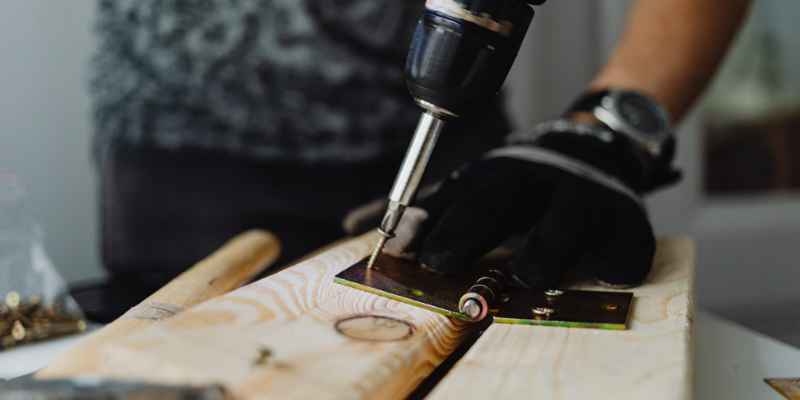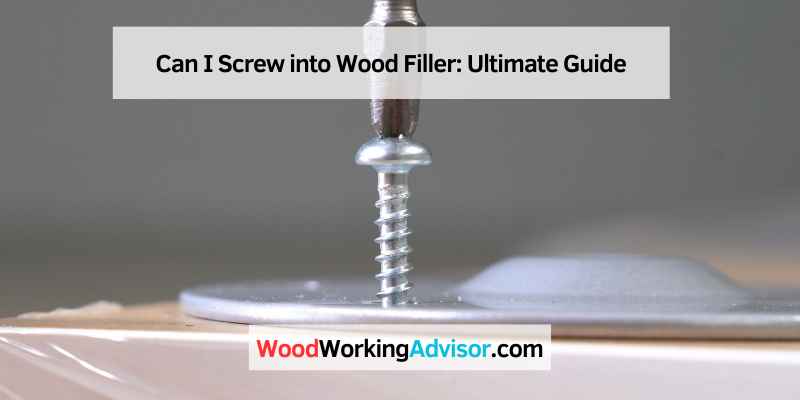Yes, you can screw into wood filler. Contractors often use wood filler and drill pilot holes for screws in various projects.
Whether it’s an epoxy-based or water-based wood filler, it can provide a satisfactory solution when minimal weight is expected to be borne by the screws. However, it’s important to note that the filler alone may not provide a solid anchor, so drilling through the filler to a solid surface is recommended for a more secure fixing.
For smaller holes, a putty knife or epoxy ball is sufficient, while for larger holes, mixing sawdust or wood shavings with the filler can create a paste that can be sanded flush with the wood’s surface. Once dry, the filled area can be painted or varnished as needed.
Can You Screw Into Wood Filler?
Wondering if you can screw into wood filler? Let’s explore the properties of wood filler and important considerations before screwing into it.
Properties Of Wood Filler
Wood filler, also known as wood putty, is a versatile material used to fill holes, gaps, and cracks in wood. Here are some key properties:
- Available in various formulations such as epoxy-based and water-based compounds.
- Can be sanded, stained, and painted to match the surrounding wood.
- Comes in different colors to blend seamlessly with different wood types.
- Some high-quality wood fillers can hold screws and other fasteners without crumbling.
Considerations Before Screwing
Before screwing into wood filler, it’s important to consider the following:
- Ensure the wood filler has fully cured and hardened before attempting to screw into it.
- Use a pilot hole to prevent the wood filler from cracking or splitting when driving in the screws.
- For structural projects or heavy load-bearing applications, opt for a high-strength wood filler or epoxy-based compound that can withstand the screwing process.
In conclusion, it’s entirely possible to screw into wood filler when done correctly, taking into account the type of filler and the application. By understanding the properties of wood filler and considering important factors before screwing, you can effectively utilize wood filler for various woodworking projects.
Types Of Wood Filler
Absolutely, wood filler can support screws. Whether it’s a stripped screw or a pilot hole, Minwax Wood Filler can do the job. It’s feasible to drill and re-screw into hardened wood fillers, providing reliable anchor support. For larger holes, consider mixing sawdust or wood shavings with a paste for a sturdy fix.
Epoxy-based Wood Filler
Epoxy-based wood filler is a type of wood filler that is highly durable and strong, making it an excellent choice for structural projects. It is a two-part compound that consists of a resin and a hardener, which must be mixed together before application. Once cured, epoxy-based wood filler becomes extremely hard and can hold screws or other fasteners without crumbling.
Solvent-based Wood Filler
Solvent-based wood filler, also known as solvent-based putty, is another popular type of wood filler. It is made by mixing wood fibers, such as sawdust, with a binder and a solvent. This type of wood filler is easy to apply, as it can be spread or molded into the desired shape. Once it dries, solvent-based wood filler hardens and can be sanded or painted over. It is suitable for both small and large holes in wood.
When it comes to using screws with wood filler, it is important to consider the type of wood filler you are working with. For structural projects, such as building furniture or cabinets, epoxy-based wood filler is recommended. It provides a strong and durable bond, allowing you to confidently drive screws into the filled area without the risk of the wood filler crumbling or breaking apart.
On the other hand, solvent-based wood filler may not have the same level of strength as epoxy-based filler. While it is suitable for minor repairs and fixing small holes, it may not be ideal for heavy-duty projects. However, if you are using screws in conjunction with solvent-based wood filler for lightweight applications, such as hanging decorative items, it can still provide sufficient support.
In summary, when using wood filler with screws, it is important to choose the right type of wood filler for your specific project. Epoxy-based wood filler is best for structural projects where additional strength and durability are required, while solvent-based wood filler is suitable for smaller repairs and lightweight applications. By selecting the appropriate wood filler, you can ensure a solid and secure anchor for your screws.
Preparation And Process
To ensure a secure hold, it is possible to screw into wood filler after properly drilling a pilot hole. The integrity depends on the type of filler used and the intended weight-bearing capacity of the screw. Adding material like sawdust or shavings to the filler can strengthen the connection for heavier loads.
Process:
- Use putty knife or epoxy ball for small holes
- Apply filler and allow it to dry
- Sand the surface flush with the wood
Process:
- Mix filler with sawdust or wood shavings for large holes
- Form a paste-like consistency
- Fill the hole and let it cure
- Sand the area smooth and finish as needed
Introductory Paragraph
When fixing screw holes in wood filler, preparation is key. Whether you are dealing with small or large holes, the process involves selecting the right filler and applying it correctly to ensure a strong anchor for your screws.
Tips For Screw Application
When it comes to screwing into wood filler, there are certain tips and techniques that can help ensure a successful outcome. Below are some key considerations to keep in mind when applying screws to wood filler:
Creating Pilot Holes
- Create pilot holes before attempting to screw into wood filler.
- Pilot holes help guide the screw and prevent splitting or cracking of the filler.
- Use a drill bit slightly smaller than the screw diameter for the pilot hole.
Applying Pressure And Stability
- Apply consistent pressure while screwing into the wood filler to avoid stripping the screw.
- Ensure the workpiece is stable and secure to prevent shifting during screw application.
- Use a screwdriver or drill with the appropriate torque setting for smooth insertion.
Alternative Solutions
If you’re looking for an alternative solution to screw into wood filler, using wood putty can be an excellent option. Wood putty is a versatile material that can be easily molded and shaped to match the wood grain. It is available in various colors, making it easy to find a suitable match for your project. To use wood putty, follow these steps:
- Prepare the surface: Make sure the area where you plan to apply the wood putty is clean and free of debris. Sand the surface if necessary to create a smooth and even surface.
- Apply the putty: Simply press the wood putty into the hole or crack using a putty knife. Make sure to fill the hole completely and smooth out the surface.
- Let it dry: Allow the wood putty to dry completely according to the manufacturer’s instructions. This typically takes a couple of hours.
- Sand and finish: Once the wood putty is dry, use sandpaper to smooth the surface and blend it seamlessly with the surrounding wood. Finish the wood as desired, such as staining or painting.
If you prefer a more budget-friendly option, you can create your own DIY wood filler. Here’s how:
- Gather materials: You’ll need sawdust from the same type of wood as your project, wood glue, and a mixing container.
- Mix the ingredients: In the mixing container, combine the sawdust and wood glue in a 1:1 ratio. Stir well until the mixture reaches a thick, dough-like consistency.
- Apply the filler: Use a putty knife to apply the DIY wood filler to the hole or crack. Make sure to fill it completely and smooth out the surface.
- Let it dry: Allow the filler to dry thoroughly, usually overnight, before sanding and finishing.
It’s important to note that while wood filler can be a viable option for screwing into, it may not provide the same level of strength and stability as solid wood. Therefore, it’s essential to assess the weight-bearing requirements of your project before deciding if wood filler is suitable.

Expert Opinions
When it comes to the question, “Can I screw into wood filler?” expert opinions vary based on the perspectives of contractors and the insights shared within the woodworking community. Let’s take a closer look at how these experts weigh in on this topic.
Contractor’s Perspective
Contractors have encountered numerous scenarios where the use of wood filler was followed by the need to drill pilot holes for screws. As one contractor put it, they have successfully drilled and re-screwed into hardened Minwax Wood Filler, emphasizing that it is possible to work with wood filler as a base for securing screws. Additionally, they mentioned that the ability to drill through the filler is crucial for achieving a solid anchor solution.
Woodworking Community’s Input
The woodworking community suggests a variety of approaches for filling screw holes in wood. For small holes, using a putty knife or epoxy ball is recommended, while larger holes may benefit from mixing in sawdust or wood shavings to form a paste. Furthermore, certain wood fillers, such as epoxy-based compounds or solvent-based variants, are noted for their ability to support screws and other fasteners without compromising strength when cured.
Frequently Asked Questions For Can I Screw Into Wood Filler
Can Screws Go Into Wood Filler?
Yes, screws can go into wood filler. It is common practice to drill pilot holes in wood filler for screws.
Can You Drill Through Filler?
Yes, you can drill through wood filler to solid surface for fixing, but it won’t provide a solid anchor on its own. For small holes, a putty knife or epoxy ball suffices. For larger holes, mix in sawdust or wood shavings to form a paste.
How Do You Fill Screw Holes In Wood?
You can fill small holes with a putty knife or epoxy ball. Mix in sawdust or wood shavings for larger holes. Once the epoxy dries, sand and paint as needed. For structural projects, consider using epoxy wood filler, which can hold screws without crumbling.
Is Wood Filler As Strong As Wood?
Wood filler is not as strong as wood. While it can hold screws or other fasteners without crumbling, for structural projects, using epoxy wood filler or solvent-based wood filler is recommended for filling large gaps without losing considerable strength.
Conclusion
The answer is yes, you can screw into wood filler. Many contractors have used products like Minwax Wood Filler to fill holes and then successfully drilled pilot holes for screws. However, it’s important to note that wood filler alone may not provide a solid anchor solution.
It is recommended to drill through the filler and into a solid surface for a secure connection. Additionally, when filling larger holes, you can expedite the drying process by inserting a small cutoff piece of wood into the gap. Overall, utilizing screwable wood filler can be a viable option for lighter weight applications.


